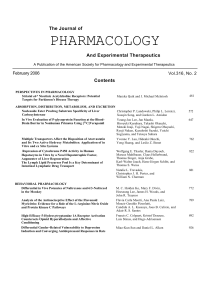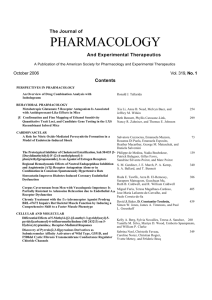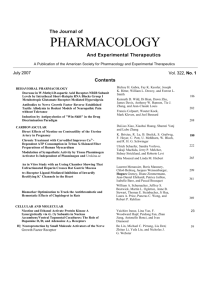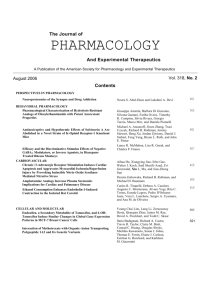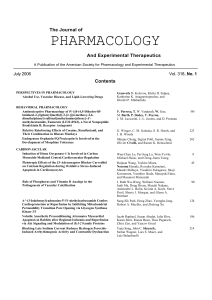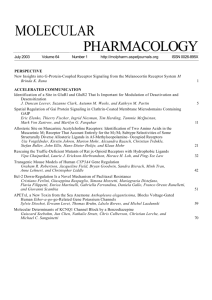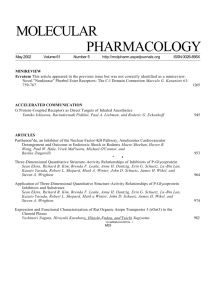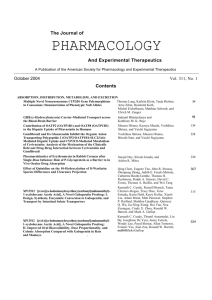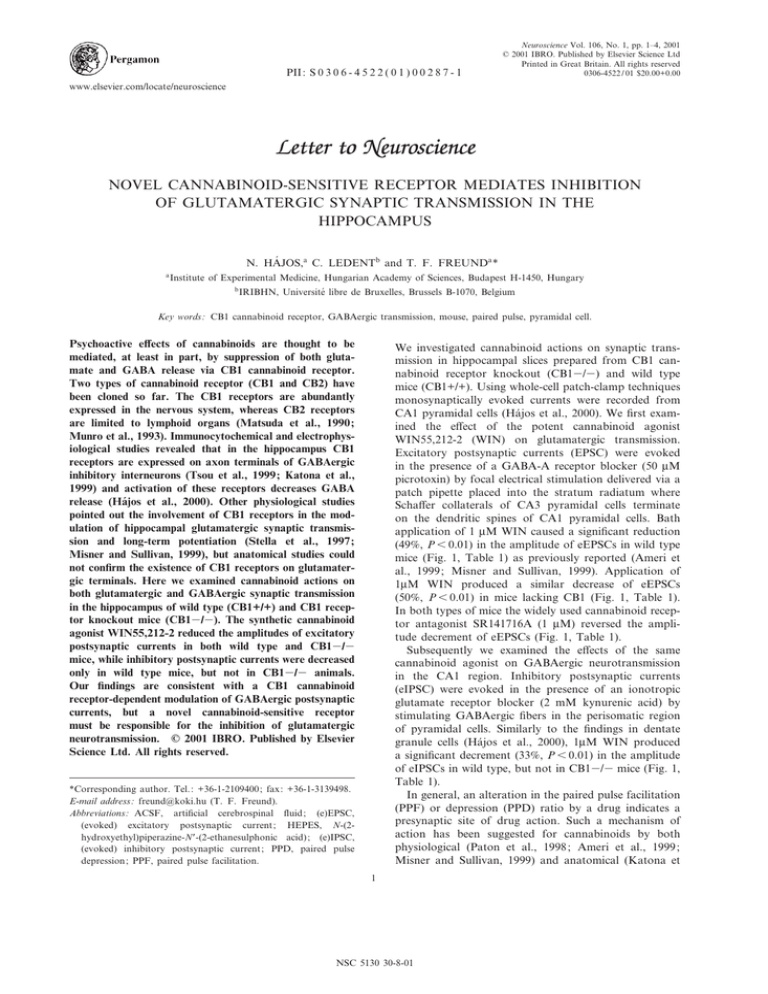
PII: S 0 3 0 6 - 4 5 2 2 ( 0 1 ) 0 0 2 8 7 - 1
Neuroscience Vol. 106, No. 1, pp. 1^4, 2001
ß 2001 IBRO. Published by Elsevier Science Ltd
Printed in Great Britain. All rights reserved
0306-4522 / 01 $20.00+0.00
www.elsevier.com/locate/neuroscience
Letter to Neuroscience
NOVEL CANNABINOID-SENSITIVE RECEPTOR MEDIATES INHIBITION
OF GLUTAMATERGIC SYNAPTIC TRANSMISSION IN THE
HIPPOCAMPUS
è JOS,a C. LEDENTb and T. F. FREUNDa *
N. HA
a
Institute of Experimental Medicine, Hungarian Academy of Sciences, Budapest H-1450, Hungary
b
IRIBHN, Universitë libre de Bruxelles, Brussels B-1070, Belgium
Key words : CB1 cannabinoid receptor, GABAergic transmission, mouse, paired pulse, pyramidal cell.
Psychoactive e¡ects of cannabinoids are thought to be
mediated, at least in part, by suppression of both glutamate and GABA release via CB1 cannabinoid receptor.
Two types of cannabinoid receptor (CB1 and CB2) have
been cloned so far. The CB1 receptors are abundantly
expressed in the nervous system, whereas CB2 receptors
are limited to lymphoid organs (Matsuda et al., 1990;
Munro et al., 1993). Immunocytochemical and electrophysiological studies revealed that in the hippocampus CB1
receptors are expressed on axon terminals of GABAergic
inhibitory interneurons (Tsou et al., 1999; Katona et al.,
1999) and activation of these receptors decreases GABA
release (Häjos et al., 2000). Other physiological studies
pointed out the involvement of CB1 receptors in the modulation of hippocampal glutamatergic synaptic transmission and long-term potentiation (Stella et al., 1997;
Misner and Sullivan, 1999), but anatomical studies could
not con¢rm the existence of CB1 receptors on glutamatergic terminals. Here we examined cannabinoid actions on
both glutamatergic and GABAergic synaptic transmission
in the hippocampus of wild type (CB1+/+) and CB1 receptor knockout mice (CB13/3). The synthetic cannabinoid
agonist WIN55,212-2 reduced the amplitudes of excitatory
postsynaptic currents in both wild type and CB13/3
mice, while inhibitory postsynaptic currents were decreased
only in wild type mice, but not in CB13/3 animals.
Our ¢ndings are consistent with a CB1 cannabinoid
receptor-dependent modulation of GABAergic postsynaptic
currents, but a novel cannabinoid-sensitive receptor
must be responsible for the inhibition of glutamatergic
neurotransmission. ß 2001 IBRO. Published by Elsevier
Science Ltd. All rights reserved.
We investigated cannabinoid actions on synaptic transmission in hippocampal slices prepared from CB1 cannabinoid receptor knockout (CB13/3) and wild type
mice (CB1+/+). Using whole-cell patch-clamp techniques
monosynaptically evoked currents were recorded from
CA1 pyramidal cells (Häjos et al., 2000). We ¢rst examined the e¡ect of the potent cannabinoid agonist
WIN55,212-2 (WIN) on glutamatergic transmission.
Excitatory postsynaptic currents (EPSC) were evoked
in the presence of a GABA-A receptor blocker (50 WM
picrotoxin) by focal electrical stimulation delivered via a
patch pipette placed into the stratum radiatum where
Scha¡er collaterals of CA3 pyramidal cells terminate
on the dendritic spines of CA1 pyramidal cells. Bath
application of 1 WM WIN caused a signi¢cant reduction
(49%, P 6 0.01) in the amplitude of eEPSCs in wild type
mice (Fig. 1, Table 1) as previously reported (Ameri et
al., 1999; Misner and Sullivan, 1999). Application of
1WM WIN produced a similar decrease of eEPSCs
(50%, P 6 0.01) in mice lacking CB1 (Fig. 1, Table 1).
In both types of mice the widely used cannabinoid receptor antagonist SR141716A (1 WM) reversed the amplitude decrement of eEPSCs (Fig. 1, Table 1).
Subsequently we examined the e¡ects of the same
cannabinoid agonist on GABAergic neurotransmission
in the CA1 region. Inhibitory postsynaptic currents
(eIPSC) were evoked in the presence of an ionotropic
glutamate receptor blocker (2 mM kynurenic acid) by
stimulating GABAergic ¢bers in the perisomatic region
of pyramidal cells. Similarly to the ¢ndings in dentate
granule cells (Häjos et al., 2000), 1WM WIN produced
a signi¢cant decrement (33%, P 6 0.01) in the amplitude
of eIPSCs in wild type, but not in CB13/3 mice (Fig. 1,
Table 1).
In general, an alteration in the paired pulse facilitation
(PPF) or depression (PPD) ratio by a drug indicates a
presynaptic site of drug action. Such a mechanism of
action has been suggested for cannabinoids by both
physiological (Paton et al., 1998; Ameri et al., 1999;
Misner and Sullivan, 1999) and anatomical (Katona et
*Corresponding author. Tel. : +36-1-2109400; fax: +36-1-3139498.
E-mail address: freund@koki.hu (T. F. Freund).
Abbreviations : ACSF, arti¢cial cerebrospinal £uid; (e)EPSC,
(evoked) excitatory postsynaptic current; HEPES, N-(2hydroxyethyl)piperazine-NP-(2-ethanesulphonic acid); (e)IPSC,
(evoked) inhibitory postsynaptic current ; PPD, paired pulse
depression; PPF, paired pulse facilitation.
1
NSC 5130 30-8-01
2
N. Häjos et al.
Fig. 1. The CB agonist WIN inhibits glutamatergic synaptic transmission, but not GABA release in CB1 receptor knockout
mice. (a) In CA1 pyramidal neurons of both CB1+/+ and CB13/3 mice the amplitudes of monosynaptically evoked EPSCs
were reduced in a similar manner by bath application of 1 WM WIN. (b) The e¡ects of WIN could be reversed by 1 WM
SR141716A (SR), a cannabinoid receptor antagonist. (c) WIN (1 WM) decreased the amplitudes of eIPSCs in CB1+/+ mice,
but had no e¡ect in CB13/3 animals. Data points represent a mean þ S.E.M. of 6 or 12 consecutive events recorded in
pyramidal cells. Inserts are averaged records of 6^10 consecutive events taken at the labeled time points. The stimulus artifacts were removed from the traces. Scale bars = 100 pA and 10 ms.
al., 1999, 2000; Häjos et al., 2000) studies. We measured
cannabinoid e¡ects on PPF of EPSCs evoked at 50-ms
intervals. As reported previously (Misner and Sullivan,
1999), in wild type mice 1 WM WIN signi¢cantly
increased PPF (2.09 þ 0.17 in WIN compared with
1.54 þ 0.07 in control arti¢cial cerebrospinal £uid
(ACSF), respectively; P 6 0.001, paired t-test, n = 10;
Fig. 2). A comparable increment in PPF was observed
after WIN application in mice lacking CB1 receptors
(2.08 þ 0.16 in WIN compared with 1.67 þ 0.12 in control
ACSF, respectively; P 6 0.001, paired t-test, n = 11;
Fig. 2). We next investigated cannabinoid actions on
PPD of IPSCs evoked at 200-ms intervals. In wild type
mice the PPD was signi¢cantly decreased after cannabinoid application (1 WM WIN) (control ACSF,
0.63 þ 0.04; in WIN, 0.75 þ 0.06; P 6 0.01, paired t-test,
n = 4; Fig. 2). In CB13/3 mice, no change was found in
PPD before and after drug application (control ACSF,
0.78 þ 0.05; in WIN, 0.77 þ 0.04; P s 0.05, paired t-test,
n = 4; Fig. 2). The PPF of eEPSCs recorded in control
ACSF was similar between CB1+/+ and CB13/3 mice
(1.54 þ 0.07 and 1.67 þ 0.12, respectively, Mann^Whitney
U-test, P s 0.1). In contrast, the PPD of eIPSCs under
control conditions was signi¢cantly less in knockouts
compared to that recorded in wild type mice (i.e.,
0.63 þ 0.04 for CB1+/+ and 0.78 þ 0.05 for CB13/3,
NSC 5130 30-8-01
CB1 receptors are not involved in EPSCs reduction
3
Table 1. E¡ect of cannabinoid agonist (WIN; 1 WM) and antagonist SR141716A (SR; 1 WM) on the amplitude of evoked postsynaptic
currents recorded in CA1 hippocampal pyramidal cells of adult wild type (CB1+/+) and knockout (CB13/3) mice
Current
eEPSC
eIPSC
Mouse type
CB1+/+
CB1+/+
CB13/3
CB13/3
CB1+/+
CB13/3
N
10
3
11
4
5
4
Drugs
Amplitude (pA)
WIN
WIN+SR
WIN
WIN+SR
WIN
WIN
Ratio D/C (%)
Control
Drug
242.1 þ 20.9
293.7 þ 34.6
289.9 þ 29.9
324.7 þ 55.3
415.9 þ 60.6
495.7 þ 70.0
120.9 þ 9.1
258.8 þ 25.9
144.1 þ 17.2
304.4 þ 42.4
280.6 þ 36.7
480.7 þ 73.9
50.9 þ 2.6*
88.8 þ 6.1
50.1 þ 2.8*
96.5 þ 6.3
66.9 þ 5.5*
96.3 þ 2.1
Data are the mean þ S.E.M. *Signi¢cant decrement after drug application (paired t-test, P 6 0.01). The drug/control (D/C) ratio represents the
decrement of the amplitude induced by WIN application.
Mann^Whitney U-test, P 6 0.05). This di¡erence was
abolished by WIN application (CB1+/+ in WIN,
0.75 þ 0.06, and CB13/3 in control ACSF 0.78 þ 0.05,
Mann^Whitney U-test, P s 0.5). Thus, deletion of CB1
receptors in mice altered only the action of the cannabinoid agonist on inhibitory transmission, but left its e¡ect
on glutamate release unchanged.
Earlier studies have shown the hippocampal formation
to be one of the brain regions with the highest density of
cannabinoid receptor binding (Herkenham et al., 1991).
Recent immunocytochemical studies using speci¢c antibodies developed against either the N- or C-terminus of
the CB1 receptor showed that in the hippocampus these
receptors are abundantly expressed on axon terminals of
GABAergic inhibitory interneurons containing the neuropeptide cholecystokinin (Katona et al., 1999, 2000;
Häjos et al., 2000). In addition, electrophysiological
and pharmacological experiments con¢rmed the predictions of these anatomical observations by demonstrating
the reduction of hippocampal GABAergic postsynaptic
currents and GABA release by cannabinoids in both
rodents and humans (Katona et al., 1999, 2000; Häjos
et al., 2000; Ho¡man and Lupica, 2000). Several
physiological studies have emphasized the modulatory
action of CB1 receptors in hippocampal glutamatergic
synaptic transmission and long-term potentiation (Stella
et al., 1997; Paton et al., 1998; Ameri et al., 1999;
Misner and Sullivan, 1999). In sharp contrast with
these latter observations, even the most painstaking
analysis at the electron microscopic level using sensitive
antibodies and techniques was unable to reliably detect
CB1 receptor immunostaining in axon terminals forming
asymmetric (mostly glutamatergic) synapses in the
hippocampus (Katona et al., 1999, 2000; Häjos et al.,
2000).
Our recent anatomical data showing the absence of
CB1 receptor immunostaining in CB13/3 knockout
mice in parallel with the lack of suppression of IPSC
by cannabinoids strongly suggest that CB1 receptors
are involved in the modulation of hippocampal
GABAergic synaptic transmission (present study and
Häjos et al., 2000). In contrast, the persistent cannabinoid-mediated reduction of excitatory neurotransmission
in mice lacking CB1 receptors clearly indicates that a
di¡erent, so far unknown receptor type must mediate
cannabinoid actions in glutamatergic terminals.
Recent studies suggested that endocannabinoids, produced by postsynaptic neurons, may serve as retrograde
signaling molecules inhibiting the release of both GABA
(Wilson and Nicoll, 2001; Ohno-Shosaku et al., 2001)
Fig. 2. PPF of EPSCs is equally enhanced by the synthetic cannabinoid (1 WM WIN) in both CB1+/+ and CB13/3 mice (a). In
contrast, 1 WM WIN modi¢es PPD of IPSCs in wild type mice,
but not in CB1 knockouts (b). The averaged traces under control
conditions (thin lines) are superimposed onto those recorded after
drug application (thick lines). Note that the superimposed averaged traces of eIPSCs in CB13/3 completely overlap. The stimulus artifacts were removed from the traces. Scale bars = 100 pA
and 20 ms. (c) Summary plot of WIN e¡ects on the paired pulse
(PP) ratio in CB1+/+ and CB13/3 animals. All data are normalized to the PP ratios obtained in control ACSF, and are expressed
as a percentage of these respective ratios (+/+, wild type; 3/3,
CB1 knockout mice). **P 6 0.001, *P 6 0.01.
NSC 5130 30-8-01
4
N. Häjos et al.
and glutamate (Kreitzer and Regehr, 2001) from axon
terminals. Thus, according to the present results,
GABAergic transmission in the hippocampus will lose
endogenous cannabinergic control in the CB1 knockout
animals (Wilson et al., 2001), but glutamatergic transmission will not, which may introduce an imbalance in
the postsynaptic activity-dependent regulation of excitation and inhibition.
EXPERIMENTAL PROCEDURES
CB1 receptor knockout and wild type mice were generated as
described (Ledent et al., 1999). The genotype of mice was tested
by conventional polymerase chain reaction (PCR) technique. In
this study, 14th generation heterozygotes were bred together in
order to generate the CB1 knockout and control mice. Adult
male mice (CB1 wild type or knockout) were anaesthetized
with ether and then decapitated. After opening the skull, the
brain was removed and immersed into ice-cold (V4³C) modi¢ed
ACSF, which contained (in mM): 126 NaCl, 2.5 KCl,
26 NaHCO3 , 0.5 CaCl2 , 5 MgCl2 , 1.25 NaH2 PO4 , and 10 glucose. Coronal slices of the hippocampus (300 Wm in thickness)
were prepared using a Lancer Series 1000 Vibratome. The slices
were incubated in ACSF (containing (in mM): 126 NaCl,
2.5 KCl, 26 NaHCO3 , 2 CaCl2 , 2 MgCl2 , 1.25 NaH2 PO4 , and
10 glucose) for at least an hour before recordings. Whole-cell
patch-clamp recordings were obtained at 34^36³C from mouse
CA1 pyramidal cells visualized by infrared DIC video microscopy (Zeiss Axioscope, Germany). The intracellular solution
contained (mM): 140 Cs-gluconate, 2 CsCl, 2 MgCl2 ,
10 HEPES, 5 QX-314 and 2 Mg-ATP (pH 7.2^7.3 adjusted
with CsOH; osmolarity 290^300 mOsm). Stimulation was delivered via a patch pipette. IPSCs were evoked by 0.1 Hz, while
EPSCs by 0.1- or 0.2-Hz stimulation. Recordings of IPSCs were
done at a holding potential of +10 þ 5 mV. EPSCs were
recorded at a holding potential of 360 þ 5 mV. Access resistances (between 5 and 15 M6, compensated 70^75%) were frequently monitored and remained constant ( þ 20%) during the
analyzed period. Signals were recorded with an Axopatch 200B
ampli¢er (Axon Instruments, CA, USA), ¢ltered at 1^2 kHz
(eight-pole Bessel, FLA-01, Cygnus Technology, Fredericton,
Canada), digitized at 5^10 kHz (National Instruments
LabPC+A/D board, Austin, TX, USA) and analyzed o¡-line
with SCAN software (courtesy of J. Dempster, University of
Strathclyde, Glasgow, UK). Data are presented as mean
þ S.E.M.
Reagents: WIN was obtained from Tocris (UK) and were
dissolved in dimethyl sulphoxide (100 mM stock solution for
both agonists). SR141716A (dissolved as 10 mM stock) was
provided by NIDA drug supply service. Dimethyl sulphoxide
by itself had no e¡ect on postsynaptic currents up to 0.01%
concentration (n = 3).
AcknowledgementsöThis work was supported by the Howard
Hughes Medical Institute, the McDonnell Foundation, NIH
(NS 30549), and OTKA (T32251). N.H. was supported by the
Bolyai Scholarschip. C.L. is Chercheur Quali¢ë of the Fonds
National de la Recherche Scienti¢que. We thank Drs I. Katona,
K. Mackie, and I. Mody for comments and suggestions on the
manuscript.
REFERENCES
Ameri, A., Wilhelm, A., Simmet, T., 1999. E¡ects of the endogeneous cannabinoid, anandamide, on neuronal activity in rat hippocampal slices.
Br. J. Pharmacol. 126, 1831^1839.
Häjos, N., Katona, I., Naiem, S.S., MacKie, K., Ledent, C., Mody, I., Freund, T.F., 2000. Cannabinoids inhibit hippocampal GABAergic
transmission and network oscillations. Eur. J. Neurosci. 12, 3239^3249.
Herkenham, M., Lynn, A.B., Johnson, M.R., Melvin, L.S., de Costa, B.R., Rice, K.C., 1991. Characterization and localization of cannabinoid
receptors in rat brain: a quantitative in vitro autoradiographic study. J. Neurosci. 11, 563^583.
Ho¡man, A.F., Lupica, C.R., 2000. Mechanisms of cannabinoid inhibition of GABA(A) synaptic transmission in the hippocampus. J. Neurosci.
20, 2470^2479.
Katona, I., Sperlägh, B., Sik, A., Ko¬falvi, A., Vizi, E.S., Mackie, K., Freund, T.F., 1999. Presynaptically located CB1 cannabinoid receptors
regulate GABA release from axon terminals of speci¢c hippocampal interneurons. J. Neurosci. 19, 4544^4558.
Katona, I., Sperlägh, B., Maglöczky, Z., Säntha, E., Ko¬falvi, A., Czirjäk, S., Mackie, K., Vizi, E.S., Freund, T.F., 2000. GABAergic interneurons
are the targets of cannabinoid actions in the human hippocampus. Neuroscience 100, 797^804.
Kreitzer, A.C., Regehr, W.G., 2001. Retrograde inhibition of presynaptic calcium in£ux by endogenous cannabinoids at excitatory synapses onto
Purkinje cells. Neuron 29, 717^727.
Ledent, C., Valverde, O., Cossu, G., Petitet, F., Aubert, J.F., Beslot, F., Bohme, G.A., Imperato, A., Pedrazzini, T., Roques, B.P., Vassart, G.,
Fratta, W., Parmentier, M., 1999. Unresponsiveness to cannabinoids and reduced addictive e¡ects of opiates in CB1 receptor knockout mice.
Science 283, 401^404.
Matsuda, L.A., Lolait, S.J., Brownstein, M.J., Young, A.C., Bonner, T.I., 1990. Structure of a cannabinoid receptor and functional expression of
the cloned cDNA. Nature 346, 561^564.
Misner, D.L., Sullivan, J.M., 1999. Mechanism of cannabinoid e¡ects on long-term potentiation and depression in hippocampal CA1 neurons.
J. Neurosci. 19, 6795^6805.
Munro, S., Thomas, K.L., Abu-Shaar, M., 1993. Molecular characterization of a peripheral receptor for cannabinoids. Nature 365, 61^65.
Ohno-Shosaku, T., Maejima, T., Kano, M., 2001. Endogenous cannabinoids mediate retrograde signals from depolarized postsynaptic neurons to
presynaptic terminals. Neuron 29, 729^738.
Paton, G.S., Pertwee, R.G., Davies, S.N., 1998. Correlation between cannabinoid mediated e¡ects on paired pulse depression and induction of
long-term potentiation in the rat hippocampal slice. Neuropharmacology 37, 1123^1130.
Stella, N., Schweitzer, P., Piomelli, D., 1997. A second endogenous cannabinoid that modulates long-term potentiation. Nature 388, 773^778.
Tsou, K., Mackie, K., Sanudo-Pena, M.C., Walker, J.M., 1999. Cannabinoid CB1 receptors are localized primarily on cholecystokinin-containing
GABAergic interneurons in the rat hippocampal formation. Neuroscience 93, 969^975.
Wilson, R.I., Nicoll, R.A., 2001. Endogenous cannabinoids mediate retrograde signaling at hippocampal synapses. Nature 410, 588^592.
Wilson, R.I., Kunos, G., Nicoll, R.A. (2001) Presynaptic speci¢city of endocannabinoid signaling in the hippocampus. Neuron, in press.
(Accepted 8 July 2001)
NSC 5130 30-8-01

